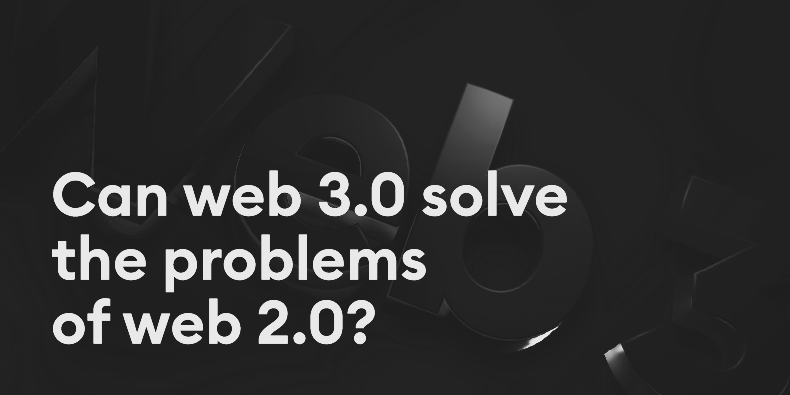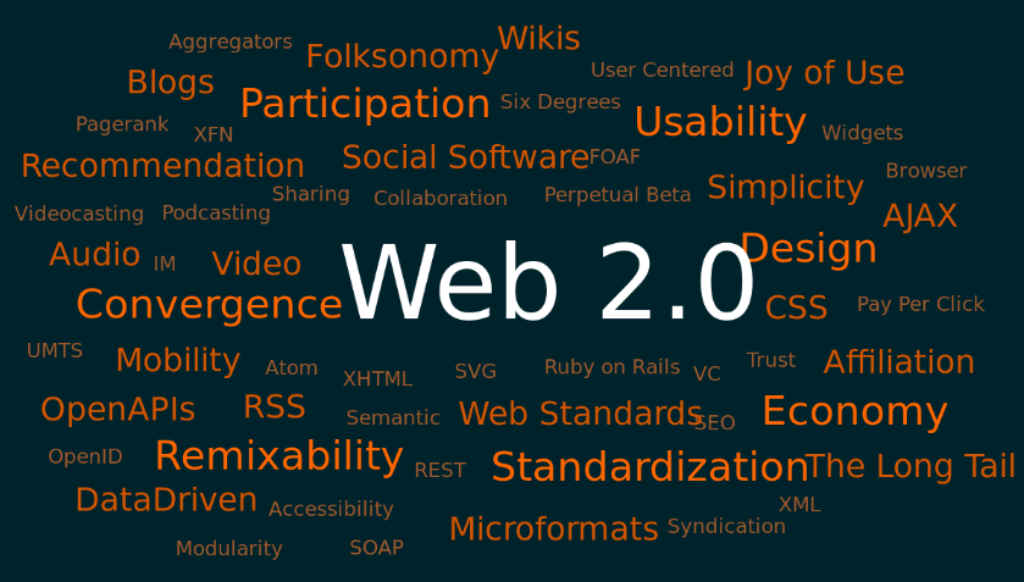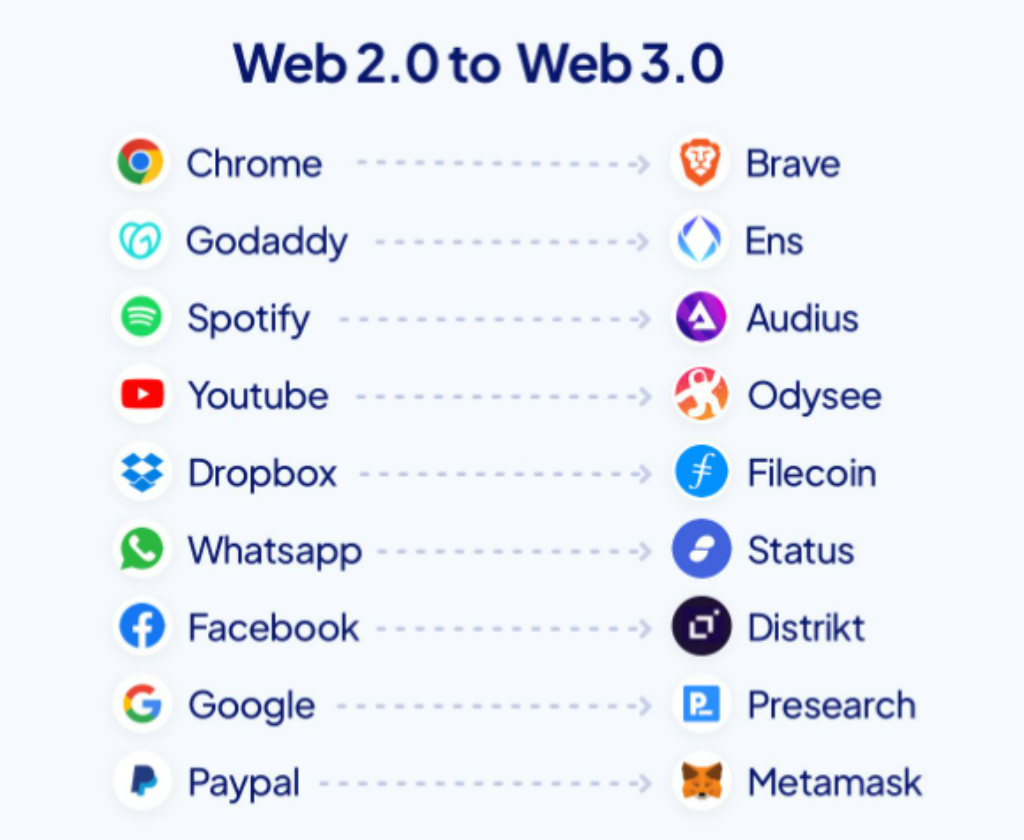
The evolution of the internet, from its early stages with Web 1.0 in 1989 to the subsequent rise of Web 2.0 in 2005, marks significant milestones in digital history. Presently, the transition towards Web 3.0 is underway, promising transformative solutions to various challenges.
One prominent concern revolves around data ownership and its exploitation by businesses for commercial purposes and influencing public sentiment. Web 3.0 endeavors to address these issues by reinstating content rights to creators and fostering a new paradigm in the digital economy.
At its essence, Web 3.0 integrates cutting-edge technologies such as automation, artificial intelligence, machine learning, and blockchain. Renowned for their transparency, security, and immutable characteristics, these technologies form the bedrock of Web 3.0’s architecture.
WHAT IS WEB 3.0?
Web 3.0 is a term used to describe the next generation of the internet, focusing on decentralization, increased privacy, and user control over data. Here are some key characteristics and examples of Web 3.0:
- Decentralization: Web 3.0 aims to reduce reliance on centralized entities like corporations or governments, distributing control and data across a network of nodes.
- Example: Blockchain technology, such as Ethereum, enables decentralized applications (DApps) that operate without a central authority. These DApps can include decentralized finance (DeFi) platforms, decentralized exchanges (DEX), and decentralized social networks.
- Increased Privacy: Web 3.0 prioritizes user privacy and data ownership, allowing individuals to control access to their personal information.
- Example: Privacy-focused browsers like Brave, which block trackers and ads by default, and protocols like Zero-Knowledge Proofs (ZKPs) used in privacy coins like Zcash, ensure transaction privacy while still maintaining transparency.
- Interoperability: Web 3.0 seeks to improve interoperability between different platforms and applications, enabling seamless data exchange and interaction.
- Example: Projects like Polkadot and Cosmos are building protocols to connect various blockchains, allowing them to communicate and share data securely.
- Semantic Web: Web 3.0 aims to enable machines to understand and interpret web content, facilitating more intelligent search and automation.
- Example: Linked Data initiatives like Schema.org provide structured data markup that allows search engines to better understand the content of web pages, improving search relevance and enabling smarter applications.
- Tokenization and Cryptoeconomics: Web 3.0 introduces tokenization of assets and the use of cryptocurrencies for various purposes like incentivizing participation, governance, and value exchange within decentralized networks.
- Example: Non-Fungible Tokens (NFTs) enable ownership and provenance tracking of digital assets like art, collectibles, and virtual real estate on blockchains like Ethereum and Flow.
Overall, Web 3.0 represents a shift towards a more open, transparent, and user-centric internet, leveraging emerging technologies like blockchain, cryptography, and artificial intelligence to create new opportunities and address challenges in the digital realm.
WHAT IS WEB 2.0?
Web 2.0 refers to the second generation of the World Wide Web, characterized by the transition from static web pages to dynamic and interactive web applications. It represents a shift from simply consuming content to actively participating and collaborating on the web. Web 2.0 emphasizes user-generated content, social media platforms, and web-based communities.

Examples of Web 2.0 technologies and platforms include:
- Social media platforms: Websites like Facebook, Twitter, Instagram, and LinkedIn allow users to create profiles, connect with others, share content such as photos, videos, and updates, and engage in conversations and interactions with a wide audience.
- Blogs and microblogging: Platforms like WordPress, Blogger, Tumblr, and Medium enable users to create and publish their own content easily. Microblogging platforms like Twitter allow users to share short updates, thoughts, and links in real-time.
- Wikis: Websites such as Wikipedia allow users to collaboratively create, edit, and organize content on various topics. Users can contribute knowledge, correct inaccuracies, and improve articles collectively.
- Content-sharing platforms: Websites like YouTube (for videos), Flickr (for photos), and SoundCloud (for audio) enable users to upload, share, and discover multimedia content. Users can comment on, like, and share content with others.
- Social bookmarking: Platforms like Pinterest and Reddit allow users to discover, save, and share interesting content from around the web. Users can vote on content (Reddit) or “pin” images and links to themed boards (Pinterest).
- Collaborative platforms: Tools like Google Docs, Dropbox, and Microsoft Office Online enable users to collaborate in real-time on documents, spreadsheets, and presentations. Multiple users can work together, edit, and comment on the same files simultaneously.
- Crowdsourcing platforms: Websites like Kickstarter and Indiegogo allow individuals to raise funds for projects, products, or causes by soliciting contributions from a large number of people online.
Here, illustrate the interactive, user-driven nature of Web 2.0, where the focus is on collaboration, sharing, and participation, rather than passive consumption of content.
Can web 3.0 solve the problems of web 2.0?
Web 3.0 is often discussed as the next phase of the internet, with characteristics such as decentralization, increased privacy, and enhanced user control over data. While it has the potential to address some of the issues present in Web 2.0, it’s important to understand that it’s not a guaranteed solution to all problems. Here’s how Web 3.0 could potentially address some of the shortcomings of Web 2.0:
- Decentralization: Web 2.0 platforms are typically centralized, meaning they are owned and controlled by a single entity. This can lead to issues such as censorship, data breaches, and monopolistic control. Web 3.0, with its emphasis on decentralization using technologies like blockchain, could distribute control and ownership of data and applications among a network of participants, reducing the power of any single entity.
- Data Privacy and Security: Web 2.0 platforms often collect large amounts of user data, leading to privacy concerns and instances of data misuse or breaches. In Web 3.0, users may have more control over their data through decentralized identity solutions and cryptographic techniques. Users could selectively grant access to their data and track its usage more securely.
- Monetization and Ownership: Web 2.0 platforms rely heavily on advertising and centralized monetization models, often at the expense of user experience and privacy. Web 3.0 could introduce new models where users have more control over their content and are directly rewarded for their contributions through mechanisms like micropayments and decentralized autonomous organizations (DAOs).
- Interoperability and Open Standards: Web 2.0 platforms are often siloed, making it difficult for users to move their data and identities between different services. Web 3.0 aims to promote interoperability through open standards and protocols, enabling seamless communication and data portability across diverse applications and platforms.
- Trust and Transparency: Web 2.0 platforms sometimes lack transparency in their algorithms and decision-making processes, leading to concerns about bias and manipulation. Web 3.0 technologies like smart contracts and decentralized governance mechanisms could enhance trust and transparency by enabling verifiable and auditable interactions without the need for intermediaries.
However, it’s important to recognize that Web 3.0 is still in its early stages, and there are challenges and trade-offs associated with its implementation. It may not completely solve all the problems of Web 2.0, and new issues may arise as the technology evolves. Additionally, widespread adoption of Web 3.0 technologies will require overcoming various technical, regulatory, and social barriers.
Can Web 3.0 Fully replace 2nd generation web?
Who win the race Web 2.0 Vs Web 3.0?
Below is a table comparing Web 2.0 and Web 3.0 in terms of various aspects. However, it’s important to note that the comparison isn’t strictly about who “wins” the race, as both have their own strengths and weaknesses, and they can coexist and complement each other in various ways.
| Aspect | Web 2.0 | Web 3.0 |
|---|---|---|
| Ownership and Control | Centralized control by corporations | Decentralized control, distributed among users/participants |
| Data Privacy and Security | User data often centralized and vulnerable | Improved privacy, user-controlled data sharing |
| Monetization Models | Advertising-driven, often intrusive | Diverse models including micropayments, decentralized finance |
| Interoperability and Portability | Siloed platforms, limited data portability | Emphasis on open standards, interoperability |
| Trust and Transparency | Lack of transparency in algorithms and decisions | Enhanced transparency through blockchain and smart contracts |
| Innovation and Experimentation | Centralized platforms dictate innovation | Decentralized ecosystem encourages experimentation |
| Scalability and Performance | Centralized platforms may face scalability issues | Scalability solutions being developed, still evolving |
| Social Impact | Facilitated global connectivity and collaboration | Potential for democratizing access, empowering individuals |
| Regulatory Challenges | Vulnerable to regulatory scrutiny and compliance | Regulatory challenges related to decentralization |

Regarding whether Web 3.0 can fully replace Web 2.0, it’s unlikely to happen in the near future, if at all. While Web 3.0 offers promising solutions to many of the shortcomings of Web 2.0, the transition would be gradual and may not result in a complete replacement. Instead, we might see a hybrid model where aspects of both Web 2.0 and Web 3.0 coexist, serving different needs and preferences of users and businesses. Additionally, Web 2.0 has established infrastructure, user bases, and business models that will likely persist alongside the emergence of Web 3.0.


